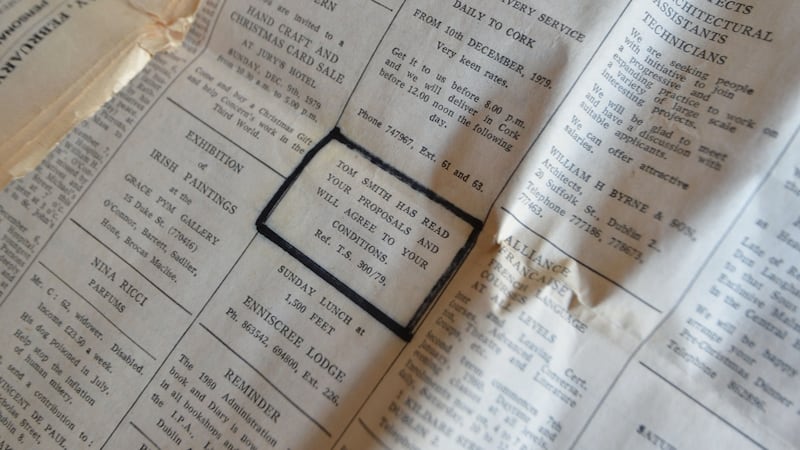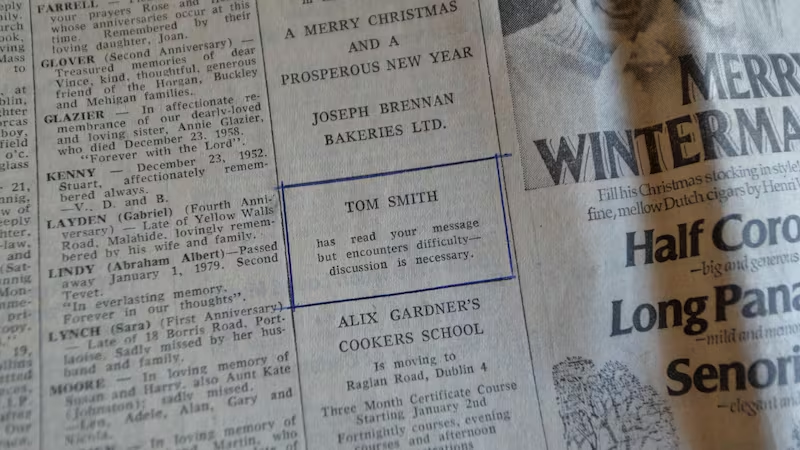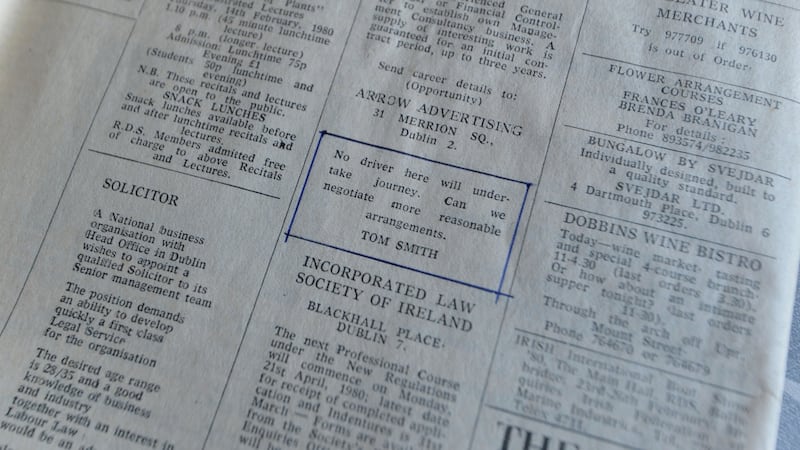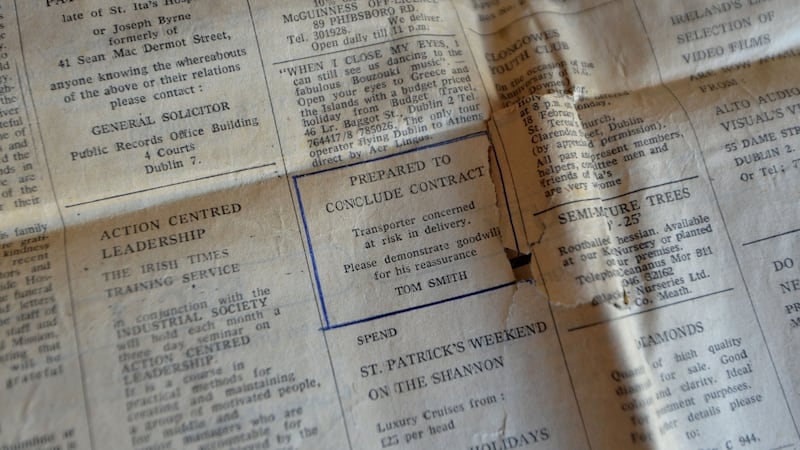The typed letter that arrived into the offices of the Department of Agriculture on Kildare Street in Dublin, addressed to the minister, was clear and to the point: "To get straight to the point, this is a demand for £5 million.
“The reason for you paying us £5 million is very simple. If you do this, we shall not introduce to this country one of the most deadly and costliest diseases that could afflict any country, in particular an agricultural country, namely foot and mouth disease.”
The letter was the opening salvo in an extortion demand that was taken extremely seriously at the time, and which has never been publicly disclosed before. Over the seven months following the letter’s receipt, communication between the State and the criminals proceeded by way of letters, a telephone call, and notices in the social and personal columns of Saturday editions of The Irish Times.
A well-known and successful barrister, and an activist with the far-left Saor Éire republican group, became the lead suspects.
The first letter arrived on Wednesday, August 29th, 1979. Jim Gibbons was the minister for agriculture, and Charles Haughey was just months away from replacing Jack Lynch as taoiseach.
A census that April had shown that the population of the Republic, which had been steadily falling in the six decades since independence, had at last changed direction. However, the State was beset by economic and social problems, with massive protest marches against the PAYE taxation system, and an ongoing security crisis because of the Troubles.
Two days before the letter was received, the IRA had killed 79-year-old Louis Mountbatten, along with an 83-year-old woman, and two teenage boys, by blowing up Mountbatten's boat off the Co Sligo coast. Already facing a tense political, economic and security situation, the State was now challenged by a seemingly serious threat to the national herd, one still hugely important to the State's economy.
The then secretary to the minister, Kevin Cassidy, remembers the letter being brought to his attention by a colleague in the office who had just opened it. Cassidy, who has never spoken about the episode before, including to his own family, has spoken about it with reporter Charlie Bird, whose series of podcasts on the event are being published from today by the Senior Times website.
“‘You should read that, Kevin,’ she said,” Cassidy told Bird. “I immediately notified senior management.”
The Garda commissioner, Patrick McLaughlin, was soon informed, and a team of top officers took charge, with everyone else being treated on a strictly need-to-know basis. One of those involved was the then detective, Willie McGee, who would go on to become the head of the fraud squad, and who is now retired.


The writer of the August 1979 letter wanted a reply placed in the personal column of The Irish Times, on Saturday, September 1st. "If you are prepared to consider our requests, simply state in the reply; 'Tom Smith has read your message and will consider your proposals.'"
If there was no response, the letter said, “We shall, as soon as cattle begin to go down, send copies of this letter to all national newspapers.”
McGee was instructed by his superiors to place the ad as demanded. “I placed the ad in The Irish Times, paid for it, got a receipt, and went back to my office,” he said. “I was no sooner back in the office when the manager of the advertising section of The Irish Times contacted my superintendent, requesting information about this, that it sounded peculiar, this particular ad.
“She was told everything was above board, and she accepted that.”
A second letter, which arrived at the department on November 29th, 1979, opened by thanking the minister for the publication of the ad on September 1st.
“Let us state from the start that we are totally determined to go through with our threats to spread this disease,” the letter said. “You and your entire department are totally helpless to stop us.”
There were five people involved, the letter said. They were from different backgrounds and each “reasonably financially secure”. They had invested time and money, including the payment of “inducements” abroad, to get to the position they were now in.
After outlining aspects of how they proposed to proceed, the writer asked that another ad be placed in The Irish Times, this one on Saturday, December 8th. “If you agree to pay the money, you will simply state ‘Tom Smith has read your proposals and will agree to your conditions.’”
The second letter was postmarked Carlow.
By this stage, according to McGee, the gardaí were already suspicious that a former Saor Éire activist living in Carlow might be involved. “A ransom demand of that nature would not be thought of by the ordinary criminal,” McGee said. “And only one person came to mind, to us all, as to who would carry out that kind of threat.”
The second ad was placed. Meanwhile, the gardaí were thinking of how they could “flush out” the criminals. They decided to place an ad in The Irish Times saying that “Tom Smith” had encountered a difficulty, and that more discussion was necessary.


A special phone line was put in place on the fifth floor of the department, with a wire going across the ceiling and out the door of Cassidy’s office, to another office across the hall. Staff were told that if a call came in for a Tom Smith, it was to be diverted to the special line, according to Cassidy.
When someone did call, at 2.55pm on Christmas Eve, the switchboard operator put the call through to the special line, and the short exchange was taped.
From the noise on the line, it was decided that the call most likely came from the UK. The extortionists said in a subsequent letter that someone had gone to London to make the call.
The caller, who was male, was told the demand that the money be paid in Irish, Swiss and German currency, was creating a difficulty.
“We can wait if necessary,” the man said in response.
The transcript of the call shows that the caller was told he was speaking to Cassidy, in the minister’s office, but this was not in fact the case. “The person answering may have said they were the minister’s secretary, but it wasn’t me,” Cassidy told Bird.
When the person who took the call started to discuss how the £5 million would be “hell of a load of currency to cart around”, the male caller hurried him on, and soon ended the call. Subsequent letters to the department were addressed to Cassidy.
The case you intend using [for the money] is to be placed on the front passenger seat
A letter received on January 15th, 1980 stipulated that a white Mini 1000 was to be prepared with English number plates and striped livery on the front and back, for eventual use in delivering the money.
The car was to be parked in "the set down bay" outside the Gresham Hotel on O'Connell Street, Dublin, between 11am and 4pm, on Saturday, February 2nd, so it could be inspected. "The case you intend using [for the money] is to be placed on the front passenger seat."
A surveillance operation was put in place, said McGee. He took up position in the P&T offices on the corner of Cathal Brugha Street with a number of colleagues. Other undercover officers were in the hotel, and in council offices across the road. The Mini was parked as directed, but two other Minis were parked up close to it in the bay.
This was done so that anyone who wanted to check the registration plates, had to come up close to the car.
Among those who were spotted inspecting the car that Saturday afternoon was a barrister McGee was familiar with from the courts. “I identified a barrister, who was a junior counsel at the time, taking particular notice of the Mini,” McGee told the podcast. “I actually took a photograph of him, standing at the Mini,” said McGee. “I was amazed to see him there.”
At the later debriefing, another member of the team reported that this same barrister had been seen visiting the home of the Saor Éire man in Carlow. “So that put him into the framework, straight away,” said McGee.
An expert’s report on the extortion letters said the language used indicated that the writer had gone to a particular “fee-paying school in the country” during the second half of the 1960s, McGee said. The barrister he had spotted looking at the Mini had attended the same school during those years.
You will receive one week's notice of the date on which we require the money to be paid
In a letter sent on February 6th the writer, after having thanked “Cassidy” for the parking of the Mini in front of the Gresham, set out in detail the route the Mini was to take on the day the money was to be delivered.
“You will receive one week’s notice of the date on which we require the money to be paid,” the letter said. “On the date that we require the money to be paid, at 4pm, the prepared car will once again park outside the Gresham Hotel and remain there with the driver and money inside the car.
“At 4.20pm the car will leave and proceed along O’Connell Street via College Green, James Street to Newlands Cross. It will then park on the lay-by at the entrance to the Dublin-Naas dual carriageway. It will remain there until exactly 5pm.
"At 5pm, it will proceed in the direction of Naas and continue through Naas, Kilcullen, Athy, Castlecomer, Kilkenny, Waterford, New Ross, Enniscorthy, Arklow, Wicklow, Bray and finally back to Dublin."
McGee said: “They obviously had done the journey themselves.”
The letter said the Mini was to be driven at 45mph. This was so the gang could work out where the car was likely to be at any time, thereby making it easier for them to watch out for it, and implement their plan, said McGee. A “shoot-out” was considered a distinct possibility, he said.
A now-retired garda named Pat, who at the time was working as an undercover policeman, volunteered for what was considered the highest-risk role in the forthcoming operation – driving the Mini.
At the time, Pat told Bird, he had long hair, and wore jeans and a chain. One of his superior officers thought he was an informant and not a police officer.
Following further communication by way of letters and advertisements in The Irish Times, the date for driving the Mini along the designated route was set for Saturday, March 8th, 1980. On the front page of that day's Irish Times, readers were told Maeve Binchy would be reporting from the Cheltenham racing festival during the following week.
Six unmarked Garda cars were assigned to the surveillance operation. The drivers were members of the fraud squad. Special branch officers armed with Uzi sub-machine guns were in the passenger seats. The surveillance cars took turns driving behind the Mini, Pat said.
McGee was issued with a snub-nosed Smith and Wesson 38 “in case of a shoot-out of any description”. Pat wore a gun strapped to his lower leg, but he also “carried a lady’s gun in my boxers. That was the back-up,” in case he was frisked.
The gardaí suspected that the best chance for the gang in trying to secure the money was by having the case pushed out onto the road as the Mini crossed bridges at either Waterford or New Ross.
Because they feared that the case might be then lowered to a boat in the water, which would speed out to sea, the Navy’s LE Emer and LE Fola were assigned to block off any attempt to escape in that way.
A male detective based in Waterford dressed up as a woman and spent the evening cycling back and forth over the bridge there, on the lookout for anything suspicious.
The Mini 1000 took off from the Gresham at 4.20pm, as instructed. The case was in the car, but didn’t have any money in it. Nothing happened at Waterford, nor at New Ross. Pat can remember spotting the male detective dressed as a woman, as he, Pat, passed over Waterford bridge.
As the Mini was approaching Arklow, Pat spotted a parked car with flashing lights up ahead, and thought this might be it.
McGee took his Smith & Wesson out of his shoulder holster, but discovered that his hand was shaking. “If a shoot-out happened, I would have been of no value whatsoever to the force, because I got a terrible shake.”
This [Saor Éire] guy that I spoke about, he was capable of anything
But it was a false alarm, and the Mini, and the six surveillance cars, completed the designated route without further incident. The cars arrived back in Dublin, and parked at the Garda HQ in the Phoenix Park, where, following a debriefing, said McGee, "we had a few pints".
Nothing was ever heard again from the writer of the letters, and it is not known why.
McGee has no doubts but that the threat was a serious one. “This [Saor Éire] guy that I spoke about, he was capable of anything.”
As for the barrister, he had a successful career, becoming a senior counsel and often featuring in high-profile court cases.
Both of the suspects are now dead. They were never interviewed, McGee said, because the law at the time did not allow for it, given the paucity of evidence that was available.
As for the special phone line in the Department of Agriculture, at some date in 1980 that he cannot remember, Cassidy came into work in the morning “and the wire was gone”.










